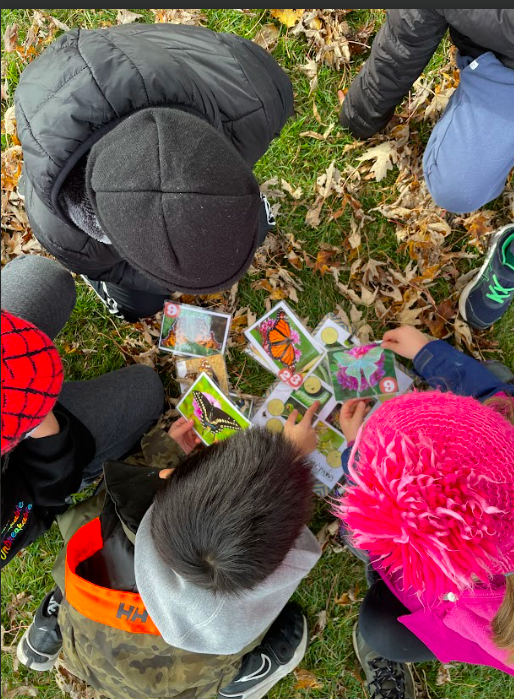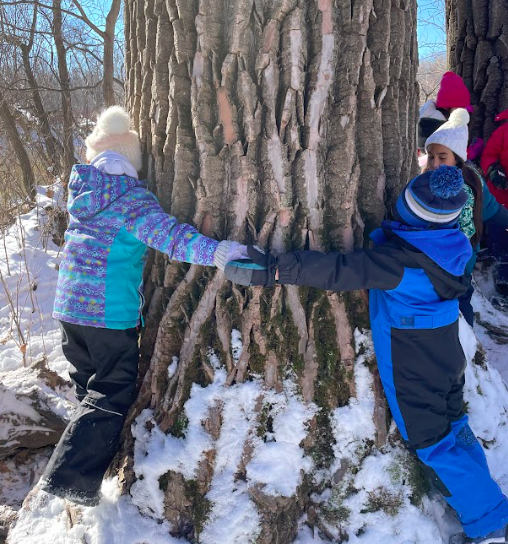
By Mira Oberman, Director of Communications and Public Programs, CPAWS Manitoba
Most people don’t need a meta-analysis of scientific research to tell them they feel good when they’re out in the woods or listening to waves lapping on the shore of the lake.
But science has come up with some fascinating ways to show how spending time outside improves mental and physical health, sometimes in surprising ways.
Connecting with the natural world has been shown to improve sleep, reduce stress boost immunity and reduce the risk of many diseases. It augments vitamin D levels, lowers blood pressure and improves eyesight. It increases endorphin levels and dopamine production, which promotes happiness.
Spending time outdoors has also been shown to improve academic outcomes in children and to alleviate symptoms of attention deficit and hyperactivity disorder (ADHD).
Exposure to nature has even been associated with improved social connectedness and lower crime rates.
Healthy forests, lakes and wetlands are working to protect our physical health even when we’re not out in nature. They clean our air, filter our water and act as a protective shield against the worsening impacts of climate change.
Why Children Need More Time in Nature

Spending time outdoors gives children improved cognitive function, better mental health and enhance socio-emotional learning, according to an extensive research digest by the Children’s Nature Network.
Yet far too many children don’t have regular access to nature.
Instead, an epidemic of excessive screen time is harming youth still struggling to recover from the emotional, economic and health impacts of the COVID-19 pandemic.
Here are troubling stats from Statistics Canada, which found that youth were spending more time on screens and less time being physically active even after the distribution of vaccines eased pandemic restrictions.
- Prior to the pandemic, just 41% of Canadian youth aged 12-17 spent less than two hours a day on screens on school days while only 21% spent more than four hours on screens. The rest fell somewhere between.
- By 2021, only 27% were spending less than two hours a day on screens while 34% spent more than four hours on screens on school days.
- Prior to the pandemic, 60% of boys and 47% of girls aged 12-17 were getting at least an hour of physical activity each day.
- By the summer of 2021, boys had mostly recovered from a pandemic slump with 57% getting an hour of exercise a day.
- There was no post-vaccine recovery among girls: just 35% were getting the recommended hour a day of exercise in the summer of 2021.
Children aged 5-11 fared far worse.
- Prior to the pandemic, 76% of Canadian children aged 5-11 met the screen time recommendation of less than two hours a day, according to ParticipACTION’s 2020 report card.
- That fell to 17% of children aged 5-11 in April 2020, before recovering somewhat to 35% in October 2020, according to ParticipACTION’s 2022 report card.
- Prior to the pandemic, 46% of 5-11-year-old children were active for at least 60 minutes a day. That fell to 18% by October 2020, according to ParticipACTION’s 2020 and 2022 report cards.
It’s not just about kids, or about screens. And it’s not just the pandemic.
Nearly two-thirds of Canadians spend less than two hours outside in a typical week, according to the 2017 Coleman Canada Outdoor Report.
This lack of time outside has been dubbed Nature Deficit Disorder, which contributes to a host of physical and emotional ill effects including poor concentration, anxiety, and obesity. Research also suggests that the nature deficit weakens ecological literacy and environmental stewardship.
When children are exposed to nature, even in simple ways or in small increments, intrigue and interest soon follow.
Highlights From a Growing Field of Research Into the Benefits of Nature

Getting out into the wilderness – away from the stress of urban noise – is the gold standard for health and wellness benefits. There’s some pretty remarkable science on the benefits of natural sounds — especially when they are free of human-related noise like traffic. Natural soundscapes can reduce stress, lower your heart rate, improve your mood, and even decrease pain.
The Japanese art of forest bathing spawned the new field of Forest Medicine, which encompasses preventative, environmental and alternative medicines. A 2019 literature review cited improved cognitive performance, drops in blood pressure and increases in levels of cancer-fighting natural killer cells among the demonstrated benefits.
Regular doses of “green exercise” create positive mental health effects, according to a 2020 meta analysis which found the impact was most profound among those who began the exercise with ‘low’ mental wellbeing: 61% moved into the ‘average to high’ wellbeing category with the support of green exercise.
Nature also helps improve sleep, according to a 2019 review of 13 sleep studies.
Just two hours a week of exposure to nature in parks or home gardens was associated with better health and wellbeing, according to a 2019 study of nearly 20,000 people in the United Kingdom.
Exposure to nature also translated into more community cohesion and substantially lower crime rates, according to a 2015 study of 2,000 people in the United Kingdom.
Even virtual exposure to nature can help reduce stress levels. A 2020 study found lower levels of the stress hormone cortisol in subjects who took a half-hour jog through a virtual forest before completing a stress test compared with those who jogged through a virtual cityscape.
CPAWS Manitoba’s Outdoor Education Program
The CPAWS Manitoba Outdoor Education Program gets kids (and adults!) outside and teaches them to appreciate the wonders of nature through games, activities and community building. It aligns with our mission to connect people to nature by teaching Manitobans about the value and beauty of our province and its wildlife.
CPAWS Manitoba taught 14,938 children and students about Manitoba’s wildlife and natural wonders through 733 place-based outdoor education workshops, field trips and activities from May 2021 to December 2023.
More than 19,000 people have registered for our Nature Club activities like group hikes, paddle nights, webinars and drop-in classes since December 2020.
We look forward to helping many more people connect to nature in the years to come.
Be sure to subscribe to our events newsletter and follow us on Facebook, Instagram, and Twitter so you don’t miss out on upcoming events.
You can register on Eventbrite and catch up on past webinars on Vimeo.
Further Reading:
The Children & Nature Network is a US-based nonprofit organization dedicated to increasing equitable access to nature so children and the natural world can thrive. It has a vast and diverse library of resources for parents, educators and urban planners ranging from toolkits to peer-reviewed research.
Outdoor Learning in Canada is an open-access resource for Canadian educators which serves as a digital textbook exploring the benefits and practice of outdoor education. A good place to start would be with the following chapters: What is Outdoor Learning? and Living today for a better tomorrow: Identifying the long-term benefits of outdoor learning over the life course.
Nature Contact and Human Health: A Research Agenda
(Environmental Health Perspectives)
This 2017 meta analysis reviews the growing body of research demonstrating an extraordinarily broad range of benefits from spending time in nature. It’s an excellent starting point for digging more deeply into the scientific research.
Ecopsychology: How Immersion in Nature Benefits Your Health
(Yale Environment 360)
A growing body of research points to the beneficial effects that exposure to the natural world has on health, reducing stress and promoting healing. Now, policymakers, employers, and healthcare providers are increasingly considering the human need for nature in how they plan and operate.
Outdoor learning provides multiple academic, social and emotional benefits for primary school children
(Children & Nature Network)
Twenty studies involving 3,283 primary-aged children from multiple countries documented positive outcomes of outdoor learning in five categories: physical activity, mental health and well-being, educational, engagement and social outcomes. Results relating to social-emotional outcomes were consistently positive and included improvements in self-awareness, emotional intelligence and communication.
Students spent more time on-task in outdoor versus indoor classrooms
(Children & Nature Network)
Three teachers in Australia participated in a study comparing student on-task behaviour in indoor versus outdoor classrooms. Tallies of teacher redirects showed less need for student redirection in the outdoor setting compared to the indoor setting. While student engagement ratings by the teachers indicated no difference between indoor and outdoor settings, overall results suggest that outdoor classrooms may reduce student misbehaviour in class.
A nature-based guidance program was effective in reducing anxiety among third grade students
(Children & Nature Network)
Four third-grade classes randomly assigned to control and experimental conditions received six weeks of guidance lessons conducted either indoors or outdoors, respectively. Anxiety assessments conducted before the six-week period showed no difference between the groups. After the six weeks, the experimental group had significantly lower anxiety scores than the control group.
A school-based nature education program had a significant, positive effect on the health-related quality of life of low-income youth
(Children & Nature Network)
This study involved 362 youth (aged 9-15) attending seven schools in low-income areas of St. Louis, MO. Some participated in a 15-week nature-based education (NBE) program; others did not. After the 15-week period, youth participating in the NBE program showed significant improvements in all five assessed health-related quality of life (HRQoL) domains and overall HRQoL. Youth not participating in the NBE program experienced significant declines in all the domain areas plus in overall HRQoL.
Nature-based environmental education programs may improve health-related quality of life and STEM capacity
(Children & Nature Network)
Black and Hispanic youth participating in a nature-based intervention program showed significant improvements in all health-related quality of life and STEM capacity domains. Evaluation results also showed that the program provided an engaging learning environment, promoted pro-environment decisions, engaged families, promoted healthy behaviours, and helped students develop leadership and team-building skills.
Higher frequency of green schoolyard use and more time outdoors are linked to self-regulation gains in kindergarten students
(Children & Nature Network)
Two groups of kindergarten students participated in a semester-long study investigating potential links between green schoolyards and self-regulation. Two measures of exposure to greenspaces were used: one measuring frequency of greenspace use; the other measuring total time outdoors. The group with higher frequency and more time outdoors showed higher gains in self-regulation.
